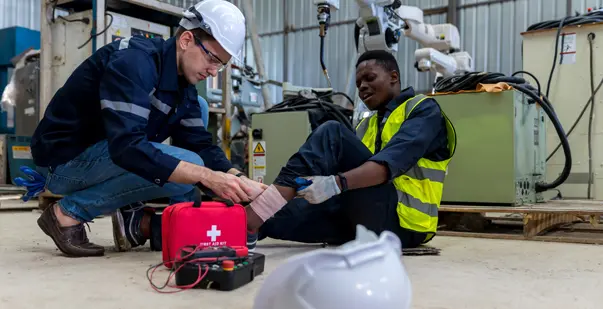In high electrical energy environments like power plants, stations and construction sites, arc flash incidents are extremely common. According to the National Fire Protection Association, almost 5-10 arc flash incidents take place on a regular basis.
To simplify, arc flash is a phenomenon where current is sustained outside its normal conductive pathway. When it comes in contact with the air that has become ionized, it creates an explosive force with bright flash and intense heat. The intense heat from an arc flash causes severe burns, and at times knock workers off their feet.
Said to be three times hotter than the sun’s surface, this guide will break down the causes of arc flash, provide essential first aid tips, and outline practical strategies to prevent these incidents.
Why do arc flashes happen?
Arc flashes happen when electrical current leaves its intended path and travels through the air to another conductor or the ground. This can create a sudden, intense burst of energy that can cause serious injuries. Several factors can lead to an arc flash:
- Equipment Failure: Old or poorly maintained equipment can break down and cause an arc flash.
- Human Error: Accidental contact with energized parts or improper use of tools can trigger an arc flash.
- Improper Installation: Incorrect installation of electrical systems can create conditions for an arc flash.
- Dust and Debris: Dust, dirt, or other particles can cause short circuits that lead to an arc flash.
- Corrosion: Rust or other forms of corrosion can weaken electrical connections, increasing the risk of an arc flash.
- Overloaded Circuits: When circuits carry more current than they are designed for, they can overheat and cause an arc flash.
- Environmental Factors: Moisture, temperature extremes, or other environmental conditions can increase the likelihood of an arc flash.
What are the steps to prevent an Arc Flash emergency?
Preventing an arc flash emergency is crucial for ensuring safety in workplaces that involve electrical systems. You can reduce the risk of an arc flash incident by following specific safety measures and best practices. Here are some essential steps to prevent an arc flash emergency:
- Equipment Maintenance: Ensure all electrical equipment is regularly inspected and maintained to prevent failures.
- Personal Protective Equipment (PPE): Always wear the correct PPE, such as arc-rated clothing, gloves, and face shields, to protect against potential arc flashes.
- Risk Assessment: Identify and assess potential hazards in the workplace to implement necessary safety measures.
- Safe Work Practices: Adhere to safe procedures when working on or near electrical equipment, including de-energizing equipment before maintenance.
- Proper Training: Provide all employees comprehensive training on arc flash risks, safety protocols, and emergency response procedures.
- Label Hazardous Areas: Mark areas with a high risk of arc flash with appropriate warning labels to keep workers informed.
- Proper Installation: Verify that all electrical systems and components are correctly installed according to safety standards.
State the first aid for Arc Flash
Providing immediate first aid after an arc flash incident minimizes injury and prevents further complications. Here’s what you should do if someone is involved in an arc flash:
- Before approaching the victim, make sure the area is safe and there is no ongoing electrical hazard.
- Immediately call 911 or emergency services for professional medical assistance.
- If it is safe to do so, disconnect the power source to prevent further injury.
- Check the victim for responsiveness, breathing, and any visible injuries.
- If the victim has burns, cool the affected area with cool (not cold) water and cover it with a clean, dry cloth. Do not apply ice or creams.
- Keep the victim lying down, elevate their legs slightly, and cover them with a blanket to prevent shock. Avoid moving them unless necessary.
- Do not touch or attempt to clean open wounds. Cover them with sterile, non-stick dressings until help arrives.
- Keep the victim calm and reassured until emergency professionals arrive.
Read More: Chemical Burns: First Aid Treatment and Prevention Tips
What are the long-term consequences for arc flash affected individuals?
The long-term consequences for individuals affected by an arc flash can be severe and life-altering. Depending on the severity of the incident, these consequences may include:
- Severe Burns: Arc flashes can cause third-degree burns. This leads to permanent scarring, disfigurement, and the need for extensive medical treatment, including skin grafts and reconstructive surgery.
- Vision and Hearing Loss: The intense light and noise from an arc flash can damage the eyes and ears. This causes partial or complete loss of vision and hearing.
- Nerve Damage: Electrical burns can damage nerves, resulting in chronic pain, numbness, and reduced mobility in affected areas.
- Psychological Impact: Experiencing an arc flash can lead to long-term psychological effects, such as post-traumatic stress disorder (PTSD), anxiety, and depression.
- Respiratory Issues: Inhalation of toxic fumes or superheated air during an arc flash can cause long-term respiratory problems, including lung damage or chronic obstructive pulmonary disease (COPD).
- Loss of Mobility: Severe injuries may result in permanent disability or reduced mobility. This impacts an individual’s ability to perform everyday tasks or return to work.
- Extended Recovery Time: Victims of arc flash incidents often require long periods of rehabilitation. They may face significant challenges in regaining their previous quality of life.
Read More: How to Treat a Burn: Diagnosis & Treatment?
How to assess potential hazards in the workplace?
Assessing potential hazards in the workplace involves identifying risks and evaluating potential impact to ensure a safe environment. Here’s a straightforward approach to conducting a hazard assessment:
- Conduct a Walkthrough Inspection:
Examine all areas where work is performed, including equipment, electrical systems, and storage areas. Look for obvious hazards such as exposed wires, malfunctioning equipment, and unsafe work practices.
- Review Safety Records and Incident Reports:
Review records of previous accidents or near-misses to identify recurring hazards or patterns. Check if there are frequent issues with equipment that could indicate underlying risks.
- Consult with Employees:
Talk to workers about their concerns and experiences with potential hazards in their daily tasks. Use their insights to identify risks that might not be immediately obvious.
- Conduct a Risk Assessment:
List all potential hazards, including physical, chemical, biological, and ergonomic risks.
Determine the likelihood and severity of each hazard, considering both the probability of occurrence and the potential impact.
- Use Safety Checklists and Standards:
Utilize industry-specific safety checklists to ensure all potential hazards are covered. Refer to safety standards and guidelines (such as OSHA regulations) to ensure compliance and thoroughness.
- Implement Control Measures:
Create and implement safety protocols to address identified hazards. Ensure appropriate personal protective equipment (PPE) is available and used correctly.
- Regularly Update Assessments:
Reassess hazards regularly and whenever there are changes in the workplace, such as new equipment or processes. Adjust safety measures as needed based on new findings or changes in regulations.
What is the importance of an arc flash training program for workers?
Due to its numerous benefits in enhancing safety and preparedness, an arc flash training program is crucial for workers in environments with electrical systems. Here’s why such training is important:
- Increases Awareness: Training helps workers understand what an arc flash is, how it happens, and the associated risks. This leads to heightened awareness and monitoring.
- Promotes Safe Practices: Workers learn best practices for working with electrical systems, including safe work procedures and the proper use of personal protective equipment (PPE).
- Improves Emergency Response: Training provides workers with knowledge on how to respond quickly and effectively in the event of an arc flash. This includes first aid and evacuation procedures.
- Reduces Accidents and Injuries: By following safe work practices and being aware of potential hazards, workers can significantly reduce the likelihood of arc flash incidents and associated injuries.
- Ensures Compliance: Many regulations and standards require arc flash training. Compliance with these requirements helps avoid legal issues and penalties.
- Enhances Equipment Maintenance: Training often includes information on maintaining electrical equipment properly, which can prevent failures that lead to arc flash incidents.
- Builds Confidence: Proper training equips workers with the skills and knowledge they need to handle electrical systems safely, boosting their confidence and competence.
- Promotes Safety Culture: A well-implemented training program contributes to a culture of safety in the workplace, encouraging everyone to prioritize and practice safety measures consistently.
OSHA training and Arc Flash: Correlation
OSHA (Occupational Safety and Health Administration) training and arc flash safety are closely related. OSHA sets standards and guidelines that directly impact how arc flash hazards are managed in the workplace. Here’s how they are correlated:
Compliance with OSHA Standards: OSHA requires employers to provide a safe working environment, which includes addressing electrical hazards such as arc flashes. OSHA’s standards, particularly those outlined in 29 CFR 1910 Subpart S, detail requirements for electrical safety, including arc flash hazard assessments and proper labeling.
Arc Flash Risk Assessment: OSHA mandates that employers conduct arc flash hazard assessments to identify and evaluate potential risks. This is a key component of OSHA training. It ensures that workers understand the need for risk assessments and the steps to take in case of an arc flash.
Training Requirements: OSHA’s regulations include specific training requirements for employees working with or near electrical systems. This training must cover the hazards associated with arc flashes, safe work practices, the proper use of personal protective equipment (PPE), and emergency response procedures.
Conclusion
Understanding arc flash incidents, along with its triggers and how to prevent them- is a crucial part of workplace safety and management. Arc flash incidents, if not properly taken care of can cause long term damages. Therefore it is important to consider common triggers like equipment failure, human error, and environmental factors. By implementing preventive measures, one can significantly reduce the chances of arc flash occurrence.
It is equally important to know how to respond effectively if an arc flash occurs. Immediate first aid, such as cooling burns, monitoring for shock, and seeking professional medical help, can make a significant difference in the outcome for affected individuals.
Last but not the least, prioritize regular training and stay updated with safety protocols to be prepared.









